Vertigo released Book 1 of its THE GIRL WITH THE DRAGON TATTOO graphic novel adaptation of the award-winning posthumously published Millennium Series novels by Stieg Larsson in 2012 in hardback, begging the question: do we really need a graphic novel of a series so popular that the novels fly off the shelves and two film adaptations (both Swedish and American) have already been made? But it’s more a question of what the comics format has to offer to the concept that the film versions haven’t done or can’t do in quite the same way. The choices that filmmakers have made in adapting the series also leave a great deal of room for alternative formats to bring out elements of the books that have been neglected or understated.
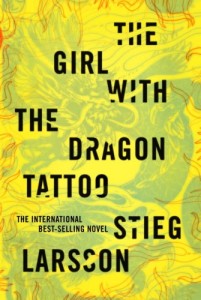
[*Spoilers for Book 1 but not for Book 2 ahead]
Firstly, there’s the English-language title, which Vertigo maintains, though the original Swedish title is, of course, Men Who Hate Women. The graphic novel series, more than the American film version, and perhaps more than the Swedish film series, emphasizes this theme with great consistency. In Book 1 from Vertigo, the narrative chapters are interspersed with what takes the place of single-issue covers or splash-pages in the form of artfully presented statistics about crimes against women in Sweden. The figures are sobering, and sometimes shocking, making American readers wonder how these stats compare to the USA. It’s a grounding in non-fictional reality that keeps reigning the story back into the society it depicts, reminding readers that the plot elements of DRAGON TATTOO may not be as fanciful as your average murder-mystery. Within the narrative of Book 1, also, smaller elements of characterization, setting, and back-story reinforce this theme even more fully than either film version. There’s a tension in the graphic novel between this overarching theme, which could well be the primary “message” of the story, and the massive gravitational pull of the appealing character, now pop culture icon, Lisbeth Salander. She steals the show at every turn. Hailed as a “super hero for grownups” by Vogue Magazine, getting sucked into her story becomes an experience of this abuse, but it’s easy to get caught up in her remarkable abilities and achievements and allow her origins in violence and trauma to fall by the wayside.
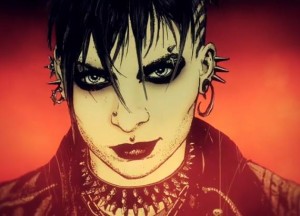
Book 2 of DRAGON TATTOO (set to be released May 7th 2013) shows the same focus, laudably, as Larsson’s series itself, and shows no signs of letting up as an investigation of gender-based crimes. Book 2 continues to cover ground contained in the first volume of the Millennium Series of books, the American film version (2011) and the two part Swedish film version of the first book, tracing the arrival of Lisbeth on the island to help shamed journalist Mikael Blomkvist piece together clues in the disappearance of another possibly wronged woman, Harriet Vanger 40 years previously. The grisly murders they investigate after deciphering coded information in Harriet’s journal reinforce the ongoing theme of the societal prevalence of violence against women.

While all of the essential plot elements that deal with violence against Lisbeth (at the hands of her state-appointed guardian), and the murder cases she investigates are present in the film adaptations, Denise Mina, who adapts the graphic novels, and Leonardo Manco and Andrea Mutti, who handle the artwork, decompress the narrative enough to give equal focus to violence against women as to action sequences and romantic encounters. This changes the feel of the storytelling and alters the reader’s sense of what the story is really “about”. It is certainly a story about a hero, Lisbeth, and a crusader, Mikael Blomkvist, but it also a story about society, a story that is essentially “ugly”, as it was branded when it first reached American readers. To be fair, the Swedish film version comes closer to giving this theme more space to breathe than the American film version, but the graphic novel trumps them both in this regard.

The graphic novel has another ace up its sleeve in terms of format in comparison to film: readers can control their own narrative pacing. But Book 1 goes beyond that allowance by including visual detail and more minor linking scenes in both Lisbeth’s and Mikael’s life that can provide more of a sense of the world that they inhabit. Manco and Mutti do an excellent job of loading panels with atmospheric elements that go beyond the utilitarian basics of storytelling. The Venger mansion is a relic loaded to the rafters with remnants of a past way of life, a kind of gracious opulence that can quickly turn into a sinister reminder of even worse times for social injustice. Giullia Brusco and Patricia Mulvihill’s colors on the graphic novel in Books 1 and 2 deserve special attention for contributing to this sense of differing social settings, from the more brash hues of Mikael’s life in the city, and later at the Venger mansion, to the more muted and moody world that Lisbeth inhabits. Brusco and Mulvihill’s wise decision to color code flashback sequences according to character works well, from Mikael’s sepia memories to Henrik Vanger’s blue-washed narratives of past events.
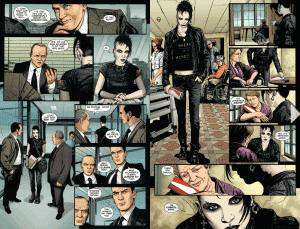
The tour de force, though, in colors, and also in lettering by Steve Wands, comes in Volume 2 when Lisbeth’s own flashbacks to recent traumatic events are depicted in a disjointed but overwhelming psychedelic repeat of phrases and images from her life, set in punk colors on a black background. Book 2 shows the same strengths as Book 1 in its unrushed pacing, attention to detail in setting, and also its commitment to establishing the psychology of its characters through preserving as much realistic minutiae as possible.

[Lisbeth Salander in the Swedish film version]
Though Manco and Mutti’s artwork is fastidious throughout Books 1 and 2, it feels most confident when depicting Lisbeth. This may be because of Manco’s “dark and gritty” style, Volume 1 touts, established through working on comics such as HELLBLAZER, is given full reign. It provides the character with quite a wow factor, boosting the sense that she’s a form of superhero, since the art style that surrounds her often stands in contrast to the more staid (but nevertheless threatening) environments she moves through. She frequently seems to explode onto the scene, even when walking quietly, and is depicted in a heroic lower than eye-level perspective. Her qualities, suggested and emphasized by the artwork, are even more apparent once she reaches the Venger estate. It’s as if her personality, and visually the art-style surrounding her, disturbs and undermines the heavily ornamented, and static, world of the past. While this visual contrast is established in Book 1, it’s even more apparent, and even more effective in Book 2 because of changing environments.
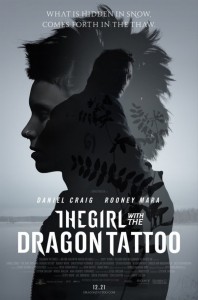
[American film version poster]
Book 1 of THE GIRL WITH THE DRAGON TATTOO was promising, setting up a lot of potential for telling a story in a way distinct from film versions that have been made, and though Book 2 by nature doesn’t have the same introductory force of Book 1, it does form a remarkably seamless development on the best features of the earlier volume from emphasizing violence against women as a governing, haunting theme, to including more detail about the lives of its characters than film versions have allowed. Book 2 also preserves and enhances Lisbeth’s hero status visually and narratively while guiding the reader deeper into the mysteries surrounding Harriet Vanger’s disappearance. If the prevailing sense created by the same team in Book 1 is “this could all be real”, Book 2 explores the implications of that assumption and so has the potential to be even more disturbing and more compelling in its revelations. If readers want realism that comes closer to the original novels by Larsson than the film versions, the graphic novels provide that alternative while still capturing the larger than life elements of the characters that have made the story such a phenomenon in the first place.
Title: THE GIRL WITH THE DRAGON TATTOO, Book 2/Publisher: DC Vertigo/Creative Team: Adapted by Denise Mina, Art by Leonardo Manco and Andrea Mutti/Colors by Giulia Brusco and Patricia Mulvihill/Letters by Steve Wands
Hannah Means-Shannon writes and blogs about comics for TRIP CITY and Sequart.org and is currently working on books about Neil Gaiman and Alan Moore for Sequart. She is @hannahmenzies on Twitter and hannahmenziesblog on WordPress.
Stieg Larsson's The Girl with the Dragon Tattoo (Quercus), the first book in the late Swedish journalist's Millennium thriller trilogy, has become only the sixth adult novel to sell more than two million copies since records began.
read more
An apparently pirated copy of the trailer for David Fincher‘s adaptation of The Girl with the Dragon Tattoo has materialized on YouTube. Above, we’ve embedded the shaky video.
According to Entertainment Weekly, the trailer features Trent Reznor and Karen O’s cover of Led Zeppelin’s “Immigrant Song” in the background. We also see glimpses of Daniel Craig as Mikael Blomkvist and Rooney Mara as Lisbeth Salander.
The trailer calls it “the feel bad movie of Christmas”–what do you think?
New Career Opportunities Daily: The best jobs in media.
 According to The Chronicle of Higher Education, eight out of the top ten titles on college campuses are nonfiction books. Decision Points by George W. Bush topped the list.
According to The Chronicle of Higher Education, eight out of the top ten titles on college campuses are nonfiction books. Decision Points by George W. Bush topped the list.
Squirrel Seeks Chipmunk by David Sedaris and The Girl with the Dragon Tattoo by Stieg Larsson were the only fiction books on the list. Life by Keith Richards and The Autobiography of Mark Twain, Volume 1 by Mark Twain joined Bush’s memoir on the list. Humor titles by Jon Stewart and Tucker Max also made the cut.
What titles did you read while you were in college? The magazine surveyed university bookstores across the country for the list. Follow this link for the complete list of participating bookstores.
New Career Opportunities Daily: The best jobs in media.
As we journey farther into the New Year, we’ve been reflecting on all the wonderful books published in 2010, and building our readings lists for 2011. The authors and friends of Oxford University Press are proud to present this series of essays, drawing our attention to books both new and old. Below, Jeanne Munn Bracken (a former librarian and award-winning author) recommends you read Steig Larsson’s trilogy this year.
By Jeanne Munn Bracken
Move over, Stephen King and Mary Higgins Clark. For the year 2010, the hottest buzz in popular literature was Swedish author Stieg Larsson’s Millennium Trilogy: The Girl with the Dragon Tattoo, The Girl who Played with Fire, and The Girl Who Kicked the Hornet’s Nest. Released over the past couple of years, the three novels are available in a wide array of formats: hardcover and paperback books, e-books, audiobooks, and now in Swedish films with English subtitles. Millions of books in dozens of countries and languages have brought the late author immense fame and fortune, although he did not live to enjoy it.
The books’ popularity is based on two major factors: the novels are real page-turners, and Larsson’s own life story is intriguing.
First, the books. The Girl with the Dragon Tattoo is an amateur sleuth mystery, as disgraced investigative reporter Mikael Blomkvist travels from Stockholm to rural Sweden to find out what happened decades ago to Harriet Vanger, a teenager who disappeared from an island under “locked room” circumstances. Woven into the search is Blomkvist’s own story, involving journalistic misdeeds that result in a jail sentence. Help arrives in the form of Lisbeth Salander, a damaged young woman in her 20s who balances her anti-social personality with consummate computer hacking skills.
After Blomkvist solves the Harriet Vanger conundrum, the subsequent books are more psychological thrillers on the noir side than classic mysteries. In The Girl Who Played with Fire, Salander takes center stage as her back-story is slowly revealed against Blomkvist’s investigation of a sex-trafficking operation that results in the deaths of two of Blomkvist’s friends and colleagues; the murderer appears to be none other than Salender herself. The barely-believable finale pits Salander against her past and sets up The Girl Who Kicked the Hornet’s Nest, which begins immediately after the conclusion of the second novel. In the third novel, political intrigue and chicanery plays out as Salander is tried for the murders.
Larsson mixes in an interesting array of characters to love or hate: Blomkvist’s long-time married lover, a handful of sociopaths, some latter-day Nazis, government operatives, police, computer hackers, and a host of journalists. While the writing is hardly fine literature, the plot zings and fostered the reputation of books that, once started, must be finished at once. With sex, intrigue, violence, revenge, laugh-out-loud humor, and quite a bit of gore, the trilogy has been popular in all age groups among many nationalities.
Larsson’s writing style, while not great literature, combines compelling plots and characters. Since the pseudonymous translator Reg Keeland rendered the books into English in a very short time and was reportedly not able to approve the final edits, the stylistic blame, if there is any, might be his. Still, “Keeland” (really
 USA Today released its “Top 100 Books for 2010″ list this week, a bestseller list composed of 77 percent fiction. Stieg Larsson‘s Millennium series dominated the top three spots and George W. Bush‘s Decision Points occupied fourth place.
USA Today released its “Top 100 Books for 2010″ list this week, a bestseller list composed of 77 percent fiction. Stieg Larsson‘s Millennium series dominated the top three spots and George W. Bush‘s Decision Points occupied fourth place.
The newspaper also noted: “Stephenie Meyer‘s popularity began to cool off. She accounted for 4% of best sellers the list tracked, down from 11% in 2009. The vampire and paranormal craze among readers isn’t dead, but it’s fading, accounting for just 9% of best sellers, down from 17% in 2009.”
The article also noted that books with movie adaptations do particularly well. It’ll be interesting to see if adaptations (like Kathryn Stockett‘s The Help) will boost sales next year.
New Career Opportunities Daily: The best jobs in media.

'Gove's new curriculum: Dangerous Book for Boys', so read a headline on the front of The Sunday Times a couple of weeks ago. Nice sound bite, but the underlying sexism of the Secretary of Education's remark made me shudder. I leaf on through the paper to find a fresh faced young man in shorts - Gareth Malone - who has a new TV series designed to get boys to read. No mention of getting girls to read, but a quick perusal of the article shows that won't be necessary because girls like nothing more than to be sitting down reading a book, while boys are 'restless and won't want to sit down as much as girls,' according to Professor Stephen Scott of King's College, London. Now, I'm all for schemes for getting children to read, and read more, but was struck by the irony that Michael Rosen, when he was Children's Laureate, also had a series on BBC 4, called Just Read, where he transformed the reading culture of a school in Cardiff and sparked the Just Read Campaign, but it would never have occurred to Michael to work with just the boys. For him, it was, and is, supremely important for ALL children to read, regardless of gender.
I find this renewed emphasis on gender alarming. It seems to be a reaction to a perceived gap in attainment. Boys are falling behind and this is a reason for a full blown moral panic. No-one thinks to congratulate girls for their levels of attainment, for actually gaining parity and pulling ahead for the first time in history. The thinking seems to be, girls are OK because they like sitting down and learning stuff, but boys have to be taught differently because they are restless creatures who can't sit down, etc. etc. - was this true of Michel Gove himself, one wonders? Or of David Cameron and George Osborne and the rest of their cohort at Eton? Or the Miliband brothers at Haverstock Comprehensive School? Hmm, probably not. I bet they were all busy learning their lessons and sitting still as still.
The thing is, I don't like genderisation. Never have. I don't like it in education and I don't like it in books. I don't like the classification of books into girls' books and boys' books. It seems to me to be every bit as pernicious as age ranging. It also means I get classified as a writer, which I don't like, either. Over the last few years, I've noted a marked increase in questions like: 'Why do you always write books for girls?' The answer is: I don't. Even if the main character is a girl, it doesn't mean that the book is specifically for girls. I write for everyone, anyone. I don't discriminate along the lines of age or gender. I'm like Philip Pullman's storyteller in the market place. There for whoever wants to stop and listen. The riposte is often: 'Why do you have girls on the cover, then?' Again, why not? 'Because boys won't read it, stupid!' Really? There's a girl on the cover of The Girl with the Dragon Tattoo and sales figures would suggest that men are reading that book.
I've got news - from the same newspaper. Men and women are not wired differently. Their brains are the same. All these supposed 'differences' are created by social conditioning and environment. There is no Men are from Mars, Women are from Venus divide. So no more girls are from Planet Pink, Boys from Planet Zarg. Genderisation in literature coarsens the appetite while restricting the fare on offer. Maybe it's time for Children's Books to ditch genderisation and grow up.
The Girl with the Dragon Tattoo presents a protagonist whose life is disintegrating. Mikael Blomkvist, a journalist, has been convicted of slandering a wealthy industrialist, and will shortly go to jail. Consequently, the magazine he publishes may fail. To occupy himself before he heads to prison, he agrees to solve an impossible mystery. All this uncertainty is key to the design of this and many stories – a beginning that can only be described as hopeless.
What interests me is why readers so willingly engage with hopeless situations. Of course, Blomkvist R Us. Our lives are a painful quandary, so we live vicariously through the struggles of the literary protagonist, yada yada yada. Yeah, we know that already. This is why we keep buying novels and watching films about people in dire straits.
But WHY is failure so compelling? An uncertain state of mind must serve us somehow. This we know instinctively.
We’ve heard it before – heartache inspires art. Adversity spawns adventure. Breakdowns present our best chance for breakthrough. But who besides a few saints chooses to suffer? No, we ignore our instincts to sustain the delusion that we are masters of our fate and captains of our soul.
But our passion for anguished heroes belies all this self-bamboozlement. Books that begin with a Blomkvist serve to connect us to an essential state of mind. One that we’re (understandably) too terrified to face in reality.
And so we read. And so we write.
 The publishers wanted a title they could take to the bank. The original Swedish title you wouldn’t take to a dog fight: Men Who Hate Women. What were they thinking over at the marketing department? Capitalizing on a red hot cultural trend, the English publishers hit on The Girl with the Dragon Tattoo, and they’ve been laughing all the way to ‘you know where’. Whether by accident or design, they also deployed one of the most powerful literary devices – a highly graphic unifying image. A literary tattoo!
The publishers wanted a title they could take to the bank. The original Swedish title you wouldn’t take to a dog fight: Men Who Hate Women. What were they thinking over at the marketing department? Capitalizing on a red hot cultural trend, the English publishers hit on The Girl with the Dragon Tattoo, and they’ve been laughing all the way to ‘you know where’. Whether by accident or design, they also deployed one of the most powerful literary devices – a highly graphic unifying image. A literary tattoo!
Symbols of any kind can help us decypher what lies at the heart of a story. Think of the mockingbird in To Kill a Mockingbird, or the white whale in Moby Dick. For that matter, who can forget the Polynesian harpooner (Queequeg) and his tattoos. Every good film or book has a compelling image that serves as the theme’s touchstone, and only rarely in film or literature has it been a tattoo.
Dragon Tattoo’s most creative invention is Lisbeth Salander, the enigmatic co-protagonist who cleans up after the hateful men in her life. Without this dark and vengeful angel the book may have proved too cruel to digest. She, of course, is the woman with the dragon tattoo.
Author Stieg Larsson didn’t over-cook the dragon motif. In fact, the tattoo is barely mentioned. In my latest novel, ROXY, I treat a tattoo motif in the same subtle fashion. Central images work best that way, just as the moral of a book or film is often buried in a minor incident. Yet the detail reverberates throughout the story. It’s just these kinds of ripples repeatedly encountered that make reading long-form fiction so enjoyable. And what makes speculating upon the writer’s intention so much fun.
So, what did the late Stieg Larrson intend with his dragon motif? Obviously he wanted to add depth to the Salander character. He wanted the reader to understand her without being told in so many unwieldy words. A tattoo has the potential to do that. What might we have expected of Lisbeth Salander if, instead of a dragon, she wore a floral design, or Our Lady of Guadalupe? We would anticipate a more forgiving character – definitely not the personality Larsson had in mind. Readers rightfully expect a character simmering with a latent vengeance capable of breathing fire.
Sometimes an author will chose an icon with significance more far-reaching than he intended. It seems to me that Larsson’s dragon also speaks to inconvenient history that the plot unearths, crimes so hideous that they could only have been committed by men held hostage by their own lizard brains.
A tattoo defines my young protagonist in the novel, ROXY. I wanted her to appear both rebellious and heart-felt. A tattoo over her heart would accomplish that, a text tattoo spelling “Shangri-La”. How could this not imply something central to her life? This is the tattoo’s uniquely powerful medicine – it serves as a talisman reflecting a person’s deepest fears or desires.
Roxy’s tattoo is a reminder of her long-dead grandmother, the person closest to her heart. While that may sound so very sentimental, the tattoo is meanwhile helping to hold the story un
I’m writing a review of “The Girl with the Dragon Tattoo” for the Vanishing Tattoo website. Author Stieg Larsson has created an unlikely duo that team up to solve the mystery of a long-ago disappearance of a young woman in a lonely Swedish landscape. Blomkvist and Salander couldn’t appear more incompatible – a middle-aged journalist, principled, disciplined and male, in league with a young, brooding, anorexic, rebellious, body-modified hacker. About the only thing they have in common is the brewing and drinking of unhealthy amounts of coffee (on just about every page, I swear it’s true). Soon, though, it’s clear that for different reasons Blomkvist and Salander have something else simmering on the back burner – vengeance.
Never mind the story – what interests me is the device of bringing together such stark opposites. It makes for great dramatic tension, not least because Salander and Blomkvist become romantically involved. It also makes the point that two people can become one super-powered organism. What if we were to extrapolate that to humanity in general?
Recently, I’ve become impressed with my limitations. I am not and never will acquire a talent for figure skating, quantum physics, or navigating FaceBook. Similarly, few people on earth have my unique passion for sounding important in print, collecting old golf clubs, and meditating. Obviously, we can’t all be everything. As a species, though, we are – all together—everything. The evolution of the human species would appear to be lurching, however painfully slowly, toward a secure ontological footing in this fact.
So what?
So this – a vicarious glimpse of wholeness is one of the rewards of reading good literature. Authors aren’t knowingly designing stories with this in mind. They don’t have to. It’s part of a protagonist’s job description to gain a larger worldview in advance of charging into Act III.
After getting sufficiently battered by the forces of antagonism, the hero starts to become disenchanted with all her best efforts and comes to learn that she is ‘only human’. If she accepts that notion, she realizes that she’s part of a larger interconnected humanity. By acknowledging our limits, we simultaneously see the advantages of surrendering to how the whole works together. We see this in stories all the time. Look for it.
By the end of “Dragon Tattoo,” the dark and tattooed angel known as Salander is just beginning to wake up to these facts of life. She has two sequels to look forward to. Two more thick volumes in which to experiment with the nearly impossible art of becoming human.
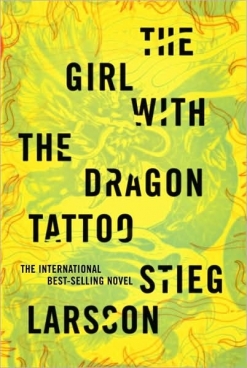 Fans of the popular “The Girl with the Dragon Tattoo” series will have to wait until late May for the final installment, “The Girl Who Kicked the Hornet’s Nest,” but they have something new to be excited about.
Fans of the popular “The Girl with the Dragon Tattoo” series will have to wait until late May for the final installment, “The Girl Who Kicked the Hornet’s Nest,” but they have something new to be excited about.
Variety reported that the film rights to “Dragon Tattoo” have been sold to Sony to produce a film based on the bestselling book. Although there has already been a film released in Sweden last February that made almost $100 million dollars across Europe, this will be the first American film based on the first trilogy.
The film will be c0-produced by the trusty Scott Rudin with the makers of Swedish film, Yellow Bird Films.
Over at MTV’s blog, they speculate who will play the tough, tattooed computer hacker turned sleuth Lisbeth Salander, who has been called “one of the most compelling characters in contemporary fiction.”
According to MTV, their choice is clear:
She is “a pale, anorexic young woman who had hair as short as a fuse, and a pierced nose and eyebrows… She was a natural redhead, but she dyed her hair raven black… She had a wide mouth, a small nose, and high cheekbones that gave her an almost Asian look.” And of course, she has a dragon tattoo (among others). With that in mind, here are our top three picks for Lisbeth:
Shannyn SossamonIf I were to leave my duties as your faithful blogger and take up a career as a Hollywood casting agent, my No. 1 pick for this role would be Shannyn Sossamon. Best known for her early ’00s roles in “A Knight’s Tale” and “40 Days and 40 Nights” this exotic brunette is a perfect physical facsimile of how I imagine Lisbeth to look.
Samaire ArmstrongAnother young starlet who’s just the right mix of delicate and dangerous is “Dirty Sexy Money” and “O.C.” actress Samaire Armstrong. Plus, with stints on T.V. crime shows like “NYPD Blue,” “Numb3rs” and “CSI: Miami,” she’s no stranger to a little detective work.
Kate MoennigWe loved Kate Moennig as tough-as-nails (with a heart of gold) lesbian Shane McCutcheon in “The L Word.” Pretty yet androgynous, we hope Kate would consider a hiatus from her role as Dr. Miranda Foster on the medical drama “Three Rivers” to step into Lisbeth’s well-worn combat boots.
Kristen Stewart of “Twilight” fame is a name that will probably pop up, although she was great in “Adventureland,” she has never come off as a “tough girl.” We will have to wait and see. Feel free to weigh in on who you think should be cast.












 USA Today released its
USA Today released its 

 Fans of the popular “The Girl with the Dragon Tattoo” series will have to wait until late May for the final installment, “The Girl Who Kicked the Hornet’s Nest,” but they have something new to be excited about.
Fans of the popular “The Girl with the Dragon Tattoo” series will have to wait until late May for the final installment, “The Girl Who Kicked the Hornet’s Nest,” but they have something new to be excited about.
[...] The Beat – The Girl With the Dragon Tattoo Volume 2 [...]